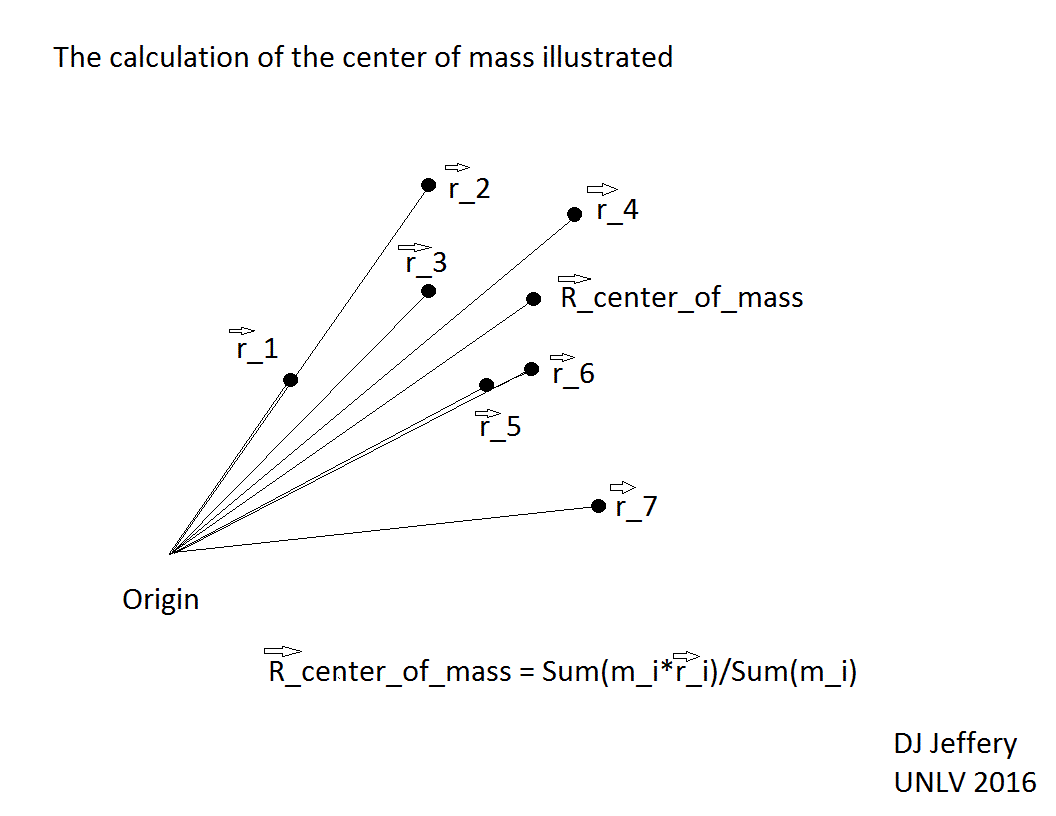
Caption: The calculation of center of mass illustrated.
Features:
- The center of mass
is a mass-weighted
average position for
a physical system.
- The
system
could be anything---fluid body,
gas sample,
set of point masses,
planetary system,
star cluster,
galaxy,
galaxy cluster---anything.
- You divide the system up mentally
into small bits (formally differential elements)
and sum
position vectors for the bits
times the bit masses and
divide by the sum of the bit masses
(which is the mass of the
system).
The result is the center of mass---more explicitly the center-of-mass position vector.
Recall, a vector is a quantity with both a magnitude and a direction.
- The formula for
center of mass is
R_cm = ∑_i (m_i*R_i) / ∑_i (m_i) = ∑_i (m_i*R_i) / m
where capital letters signify vectors, R_cm is the center of mass, i is an index for the bits, R_i is the position vector for bit i, m_i is the mass of bit i, and m is the system mass (i.e., the total mass). - The importance of the center of mass
of a system
is actually the position variable that enters into
Newton's 2nd law of motion
(AKA F=ma):
F_net_ext = m*A_cm ,
where F_net_ext is the net external force on the system, m is again the system mass, and A_cm is the center-of-mass acceleration.So it's center-of-mass motion which is determined by F=ma---a point often neglected in high-school physics courses.
- Centers of mass
are very useful in determining
inertial frames
for the analysis of both
the INTERNAL and center of mass
motions
of a system.
Center-of-mass (CM) inertial frames are discussed in Mechanics file: frame_basics.html and Mechanics file: frame_hierarchy_astro.html.
- An important factoid is that center of mass of a system equals the center of mass evaluated from the center of masses of any set of subsystems of the physical system.
Proof: Given a set of point masses i each with mass m_i and m=∑_i m_i and position vector R_i, the center of mass R_cm is determined by
mR_cm = ∑_i m_i*R_i = ∑_j (∑_i m_i*R_i)_subset_j = ∑_j m_jR_cm_j ,
where there are a general set of subsets j of point masses and m_j is the sum of the mass of the subset j. Clearly, R_cm_j is the center of mass of the subset j. Since the subsets are general, the proof is complete: QED. - An important factoid is that center of mass of a system equals the center of mass evaluated from the center of masses of any set of subsystems of the physical system.
Image link: Itself.
Local file: local link: center_of_mass_illustrated.html.
File: Mechanics file: center_of_mass_illustrated.html.